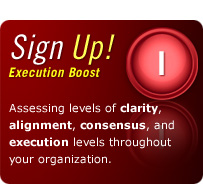Systemic Solutions to Execution Problems: The Process of Crossing the “Knowing-Doing Gap”
by John Spence
November 17th, 2007
For the past three years I have been invited to be a guest lecturer on “strategic thinking” at a special event at the University of Pennsylvania’s Wharton School of Business. Typically I have about 120 senior executives in my class and during the session I will pose this question: “What percentage of the time do companies that have a clear vision and a specific plan to achieve that vision, effectively execute to that plan?” The answer I most often get is 10-15% of the time. Wow, that is scary
This is one of the biggest issues I face in all of my consulting and training assignments. It is what we refer to in our firm as the “Knowing-Doing Gap.” Companies know what they are supposed to do, they have a solid plan to dominate their market – but creating a performance-oriented culture of disciplined execution that can effectively implement the plan seems to be a challenge that few can conquer. If that were not frustrating enough, when you step back and look at the financial implications they can be staggering. Inability to execute to plan is likely responsible for the overwhelming percentage of lost revenues in most large organizations.
The solution to this dilemma is simple, but by no means easy. As much as I hate to admit it, the only cure to this problem is: Process. The leader must put into place a detailed system; a defined and repeatable process for identifying, clarifying, prioritizing, assigning responsibility, implementing, reviewing and rewarding against specific goals and high standards of professionalism. Consistent and effective execution does not happen by chance. Again, holding a two-day offsite to build a strategic plan is a great idea, but it is merely the very first small step in a long and arduous process of making sure the plan is well communicated and effectively implemented. Only with a highly focused system of goal setting, monitoring and management to the goals, can any leader hope to keep her people on track and successful in taking their business plan and making it a business reality.
Oh, and by the way, the greatest hurdle to making this process work will be your own employees. Why? Well, it has been my experience that when you remove all of the places for people to hide and you actually hold them accountable for doing the work they promised to deliver – that they will rise up in anger and fear and attempt to subvert or destroy the system. This is because for the most part people equate monitoring and tracking as a way for management to “catch them doing something wrong” and punish them. But let me tell you a story that might turn that thinking around. Several years ago I was leading a national sales meeting form one of my top clients and the CEO was rolling out a brand new software system to help “track and monitor” the activities of the sales team. As he stood at the front of the room and spoke about the new reports and systems and processes the mood went from bad to worse. You could see the expressions of the salespeople go from concern to fear to disgust. It was about to erupt into a full-out revolt when the CEO said something that turned them all around in seconds.
Hey, hang on a second here. I want to make it clear this system is NOT about punishment, it is about help. We are not going to track you all year and then wait until your review and then use it to beat you over the head and not give you a raise.” He then looked them in the eyes and continued, “We are putting all of these checks and balances in place so we can help you. We are going to monitor you closely so we can see at the very first sign of trouble that you might be getting off track so we can rush in with help and support and training and whatever you need to keep from getting into trouble. We want to use this to make sure you can maximize your commissions and make the most money possible. This is not about punishing you after you have failed – it is about making sure we are here to support you so you never get into a place where you could fail.” This is the key to disciplined action, a specific, measurable and repeatable process for helping you people successfully implement the plan and share in the rewards.
Article Filed under: I. WATER (Team/Group Excellence)



5 Comments Add your own
1. Thomas Foxx | November 20th, 2007 at 6:04 pm
I agree, it seems that personnel structures are immediately resistant to changes even when the changes actually are design to benefit everyone. I have experienced the “Knowing-Doing Gap” through firsthand experience as an employee in an electronic production and repair department. I spent my first two years in the organization operating under the traditional process, and during my last two years I experienced the implementation of new processes.
I was the production manager at a component level repair unit. The organization decided to implement a combination of Six Sigma and Lean principles to the entire maintenance and manufacturing department. First an impartial team was assembled of employees and a group of LEAN trained members. Then, based on current employee input and observation, the group analyzed the operations needed to complete reoccurring tasks and goals. After very detailed analysis, they established procedural standards and guidelines for reoccurring tasks. Each item was given a specific timeframe for completion, personnel and support equipment requirements, and alternative methods for completion. Despite employees being a vital component in the program construction, many employees were resistant and irritated once it was implemented.
I didn’t possess a felling of “anger or fear” because of the short period I spent using traditional methods. Most people I believe were angry when confronted with the reality of upper management being able to understand who, when, and how well people executed their responsibilities. Previously people hid below average performance behind their area of expertise (which not all managers completely understood). People thought the monitoring program would be temporary, but management remained confident in the ability for the principles to improve efficiency. As a result, the division became one of the most efficient in the local industry.
2. Jonathan Branch | November 20th, 2007 at 11:45 pm
Coach Billy Donovan of the Florida Gators gave a speech to a group of people working on my team. He talked about how a team needs to work to get to a final goal, whether it be to win a few basketball games or to have a specific profit by the end of the year. The idea was to not focus on the end goal, but rather make sure each step in the process of achieving the goal was met. Finding this problem as quickly as possible, and then identifying ways to overcome the barrier is what needs to be done. By implementing systems to find out as quickly as possible is a great way to improve a team. When getting to a goal the team that does each step along the way to finishing the goal is who wins, and it is important not to focus on the end goal but rather each step.
3. John Spence | November 21st, 2007 at 10:44 am
Thomas — great comments – thank you so much — and you helped remind me of something I left out of the above article. One of the very best ways to make sure there is minimal resistance is to get the employees who will be directly affected, involved in developing the measures and the process. If they have a say = they will have a stake in the outcome and will have much more buy-in than if the system is simply inacted from above.
4. Brian Higley | November 23rd, 2007 at 10:09 pm
Thomas, Jon, and John,
I think these comments are all spot-on. I might add that it’s been my experience (from basketball teams like Billy Donovan’s to corporate teams to family systems) that people can get irritated by change – even when that change is percieved as positive by the majority of the group. It is a fascinating phenomenon – but I regularly find that it takes teams 3-6 months to become comfortable with a new process. Great leaders know this fact, I think – and know how important it is to continue good processes in the face of this frustration. Most teams report respecting this sort of leader when the change is finally brought about – even in the face of their frustration. On the other hand, many report not respecting leaders that waver in the face of change-related frustration – even if they like him or her a lot.
Good stuff – I look forward to seeing more posts from all of you!
5. Excellence Tree Journal &&hellip | February 20th, 2009 at 11:25 am
[…] you want. Prioritize. Be purposeful. Pick the tool (and the career, and the life) you love, execute with excellence, and get BAD at all the other stuff. You can pick more than one thing for sure, but you […]
Trackback this post | Subscribe to comments RSS Feed
Leave a Comment
Some HTML allowed:
<a href="" title=""> <abbr title=""> <acronym title=""> <b> <blockquote cite=""> <cite> <code> <del datetime=""> <em> <i> <q cite=""> <s> <strike> <strong>